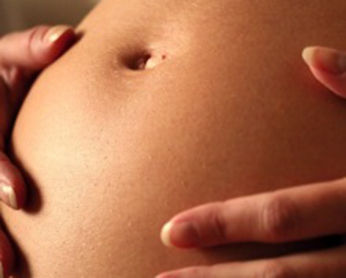Neurofibromatosis type 1 and pregnancy: a case resport
Keywords:
Neurofibromatoses/genetics, Neurofibromatosis 1, Neurofibromatosis type 1 genes, Pregnant Women.Abstract
Introduction: type 1 neurofibromatosis is a genetic disease, of autosomal inheritance, dominant, with 100% of penetrance and variable expressivity, where the halves of the cases correspond to Novo mutations.
Case report: a 28 year-old female patient of mixed race, living in urban area, pre-university education, housewife, the menarche at 16 years old, menstrual formula every 30 days lasting 5 days, first sexual relations at age 16, obstetric history: G 6, P1 (C-section) A 2 (miscarriage) and 2 (artificial abortion), no transfusions, no toxic habits, no drug allergies, previous caesarean section in 2006.
Conclusions: it is a rare incidence in pregnant women with this base disease, a case of a 28-year-old is reported, elective iterated caesarean section is planned, by intravenous general anesthetic method, prior interdisciplinary consultation, a healthy baby was born, with good Apgar score, with no maternal or neonatal complications.
DeCS: Neurofibromatoses; Neurofibromatosis 1; Neurofibromatosis 1 genes; Pregnant women; Genetics.
Downloads
References
1. Ríos Sanabria C, Mora Hernández GA. Neuro-Genética. Neurofibromatosis tipo 1
-Enfermedad de Von Recklinghausen-. Rev Med Costa Rica y Centroamérica [revista en Internet]. 2014 [citado 9 Ene 2016]; LXXI(610): 249-252. Disponible en:
http://www.medigraphic.com/pdfs/revmedcoscen/rmc-2014/rmc142n.pdf
2. Gómez M, Batista O. Neurofibromatosis tipo 1 (NF1) y su diagnóstico molecular como estrategia del diagnóstico diferencial y a edades tempranas. Rev Méd Chile [revista en Internet]. 2015 Oct [citado 11 Ene 2016]; 143(10): 1320-1330.
Disponible en:
http://www.scielo.cl/scielo.php?script=sci_arttext&pid=S0034-98872015001000011&lng=es
http://dx.doi.org/10.4067/S0034-98872015001000011
3. Dagalakis U, Lodish M, Dombi E, et al. Puberty and Plexiform Neurofibroma Tumor Growth in Patients with Neurofibromatosis Type I. The Journal of pediatrics [Internet]. 2014 [cited 2016 Jan 17]; 164(3):620-624.
doi:10.1016/j.jpeds.2013.10.081. Available from:
http://www.ncbi.nlm.nih.gov/pmc/articles/PMC3943976/
4. M Eoli. Neurofibromatosis (NF) type 1 and type 2. In: Sghirlanzoni A, Lauria G, Chiapparini L, editors. Prognosis of Neurological Diseases. Springer-Verlag Italia 2015. doi: 10.1007/978-88-470-5755-5. online ISBN 978-88-470-5755-5. Available from: http://health.springer.com/book/10.1007/978-88-470-5755-5
5. Inatomi Y, Ito T, Nagae K, Yamada Y, Kiyomatsu M, Nakano-Nakamura M, Uchi H, Oda Y, Furue M. Hybrid perineurioma-neurofibroma in a patient with neurofibromatosis type 1, clinically mimicking malignant peripheral nerve sheath tumor. European Journal Dermatology [Internet]. 2014 [cited 2016 Jan 17]; 24(3): 412-413. doi: 10.1684/ejd.2014.2353. Available from: http://health.springer.com/article/10.1684/ejd.2014.2353
6. Ramos-Zúñiga R, Saldaña-Koppel DA. Neurofibromatosis type 1 and pregnancy: The transformation of a nodular to cystic neurofibroma in the cervical region. Surgical Neurology International [Internet]. 2015 [cited 2015 Jan 9]; 6(Suppl 19):S487-S489. doi:10.4103/2152-7806.166889. Available from:
http://www.ncbi.nlm.nih.gov/pmc/articles/PMC4617023/
7. Yap Y-S, McPherson JR, Ong C-K, et al. The NF1 gene revisited – from bench to bedside. Oncotarget [Internet]. 2014 [cited 2015 Jan 9]; 5(15):5873-5892. Available from: http://www.ncbi.nlm.nih.gov/pmc/articles/PMC4171599/
8. Francis L, Subramanyam R, Mahmoud M. Severe spinal and chest deformity secondary to neurofibromatosis. Canadian Journal Anesthesia [Internet]. 2016 [cited 2016 May 5]; 63(4): 488-489. doi: 10.1007/s12630-015-0543-4. Available from: http://health.springer.com/article/10.1007/s12630-015-0543-4/fulltext.html
9. Finsterer J, Stöllberger C, Schäffl-Doweik L. Neurofibromatosis type I and anti-phospholipid antibody syndrome: Report of one case. Rev Méd Chile [Internet]. 2013 [cited 2016 Jan 15]; 141(8): 1068-1071. Available from:
http://www.scielo.cl/scielo.php?script=sci_arttext&pid=S0034-98872013000800015&lng=es
http://dx.doi.org/10.4067/S0034-98872013000800015.
10. Martin S, Wolters PL, Baldwin A, Roderick MC, Toledo-Tamula MA, Gillespie A, Widemann B. Attitudes About Internet Support Groups Among Adolescents and Young Adults with Neurofibromatosis Type 1 and their Parents. Journal Genetic Counseling [Internet]. 2014 [cited 2016 Jan 19]; 23(5): 796-804. doi: 10.1007/s10897-014-9688-5. Available from: http://health.springer.com/article/10.1007/s10897-014-9688-5/fulltext.html
11. Suzuki S, Yoshida Y, Ehara Y, Yamamoto O. Neurofibromatosis type 1 (NF1) with transient paraplegia after a surgical procedure in the prone position. European Journal Dermatology [Internet]. 2015 [cited 2016 Jan 15]; 25(5): 500-501. doi: 10.1684/ejd.2015.2617. Available from: http://health.springer.com/article/10.1684/ejd.2015.2617

Published
How to Cite
Issue
Section
License
Authors who have publications with this journal agree to the following terms: Authors will retain their copyrights and grant the journal the right of first publication of their work, which will be publication of their work, which will be simultaneously subject to the Creative Commons Attribution License (CC-BY-NC 4.0) that allows third parties to share the work as long as its author and first publication in this journal are indicated.
Authors may adopt other non-exclusive license agreements for distribution of the published version of the work (e.g.: deposit it in an institutional telematic archive or publish it in a volume). Likewise, and according to the recommendations of the Medical Sciences Editorial (ECIMED), authors must declare in each article their contribution according to the CRediT taxonomy (contributor roles). This taxonomy includes 14 roles, which can be used to represent the tasks typically performed by contributors in scientific academic production. It should be consulted in monograph) whenever initial publication in this journal is indicated. Authors are allowed and encouraged to disseminate their work through the Internet (e.g., in institutional telematic archives or on their web page) before and during the submission process, which may produce interesting exchanges and increase citations of the published work. (See The effect of open access). https://casrai.org/credit/


